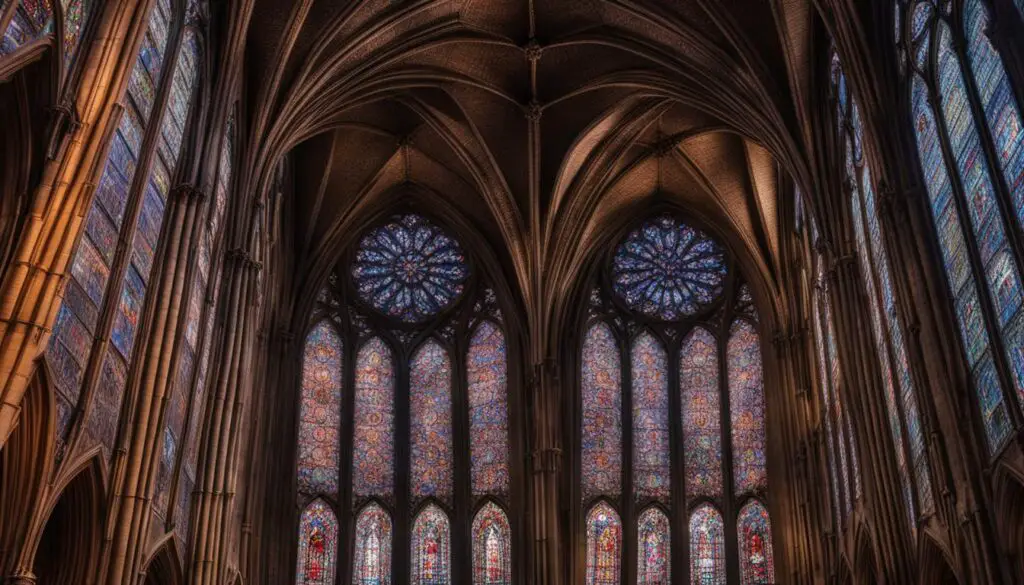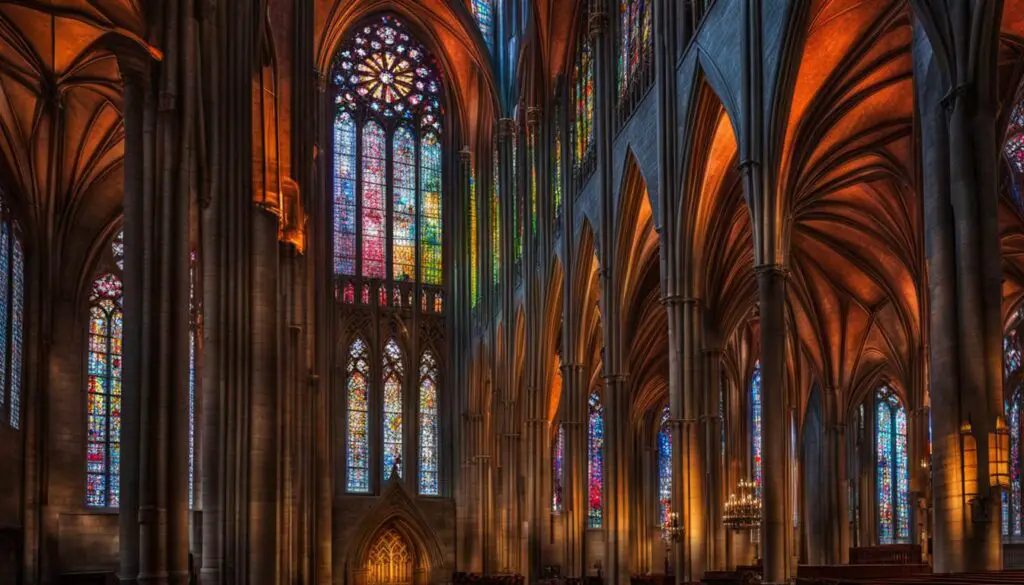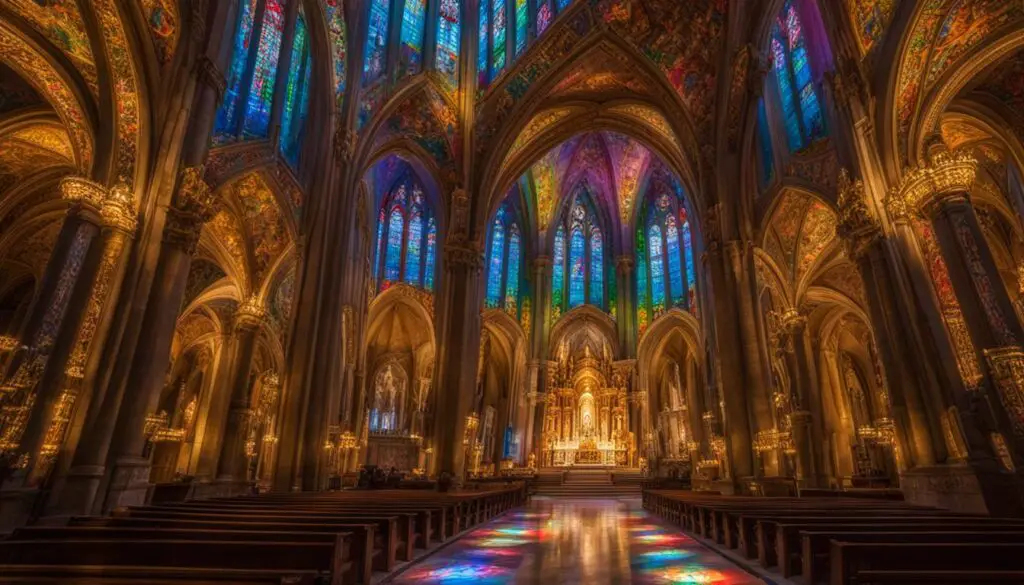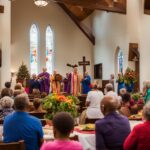Step into the ethereal world of Gothic cathedrals, where divine inspiration meets architectural mastery. These magnificent structures, with their intricate design and awe-inspiring grandiosity, have captured the hearts and minds of millions throughout history. Each element of gothic cathedral architecture is carefully crafted to evoke religious awe and elevate the human spirit.
Key Takeaways:
- Gothic cathedrals are renowned for their unique architectural design.
- Religious symbolism plays a significant role in gothic cathedrals.
- The intentional use of light creates a spiritual atmosphere in these majestic structures.
- Gothic cathedrals inspire reverence for God and foster a sense of spiritual transcendence.
- The enduring legacy of gothic cathedrals continues to captivate people around the world.
Architectural Components of Gothic Cathedrals
Gothic cathedrals are known for their distinctive architectural components that contribute to their awe-inspiring beauty and spiritual significance. These elements combine to create an immersive experience that elevates the human spirit and connects worshipers with the divine.
- Pointed Arches: The pointed arches seen in gothic cathedrals are not merely structural elements but symbolic representations of reaching towards heaven. They lend a sense of upward movement and bear the weight of the massive structures more efficiently than rounded arches.
- Flying Buttresses: Gothic architects introduced flying buttresses, external support structures, to counteract the outward pressure exerted by the vaulted ceilings. By transferring this weight to the buttresses, the walls could be opened up with larger windows and intricate designs, creating a sense of lightness and verticality.
- Tri-portal West Façades: The entrance to a gothic cathedral is usually through an elaborately adorned tri-portal west façade. These facades often feature intricate sculptures and carvings that serve as visual representations of biblical stories and themes.

Rib Vaults: Another key feature of gothic architecture is the use of rib vaults. These structural frameworks consist of diagonal arches that intersect and support the weight of the vaulted ceilings. Additionally, the ribs create a visually striking pattern on the ceilings, adding to the overall grandeur of the space.
“Gothic architecture does not hide its structural components but instead integrates them into the overall design, turning them into decorative elements that enhance the spiritual experience.”
Rose Windows: One of the most iconic elements of gothic architecture, rose windows are circular stained glass windows that allow colorful light to permeate the interior. These windows serve both a practical purpose by illuminating the space and a symbolic role by transforming natural light into a spiritual glow.
These architectural components work harmoniously to create a sense of divine transcendence within gothic cathedrals. They inspire a feeling of religious awe and invoke a deep connection to the divine, making these architectural wonders true treasures of human creativity and spiritual expression.
The Birth of Gothic: Abbot Suger & Saint-Denis
In the birth of Gothic architecture, Abbot Suger’s visionary renovations to the Basilica of Saint-Denis illuminated a new era of divine inspiration in gothic cathedrals. Inspired by his belief in the spiritual power of light, Suger embarked on a mission to create a heavenly realm on Earth through the clever design choices of gothic cathedral architecture.

Suger’s Vision: Light as Divine
“For bright is that which is brightly coupled with the bright: the sun shines brightly, the light indeed is generated with the light and rejoices in companionship with the light. Similarly shall the House of God, illumined, gladly shine with a perpetual light and be no less resplendent than the sun.”
Abbot Suger’s design philosophy revolved around the notion that light was divine and had the power to transport individuals to a higher spiritual realm. He sought to manifest this divine light within the cathedral, creating an ethereal and awe-inspiring experience for worshippers. Suger’s profound understanding of gothic cathedral design allowed him to merge architectural elements with spiritual symbolism, resulting in an extraordinary transformation of the Basilica of Saint-Denis.
Flooding Cathedrals with Light: The Use of Rose Windows
Suger’s renovations focused on maximizing the entry of natural light into the cathedral. One of his notable additions was the inclusion of rose windows, large circular stained glass windows with intricate designs. Positioned strategically on the west facade and transept, these rose windows not only illuminated the interior but also symbolized the spiritual vision of the divine.
The Ingenious Architectural Elements
To emphasize the divine presence, Suger incorporated specific architectural elements that epitomized gothic cathedral design. These elements included:
- Pointed arches: A hallmark of gothic architecture, pointed arches symbolically reached towards heaven, connecting the earthly with the divine.
- Rib vaults: The introduction of rib vaults allowed for a more efficient distribution of weight, enabling taller and lighter structures. These vaults created a sense of upward movement, visually lifting the spirit.
- Flying buttresses: Innovatively designed external support structures that redirected the weight of the roof, allowing for larger stained glass windows and taller walls without compromising stability.
Suger’s Writings: Documenting Divine Inspiration
Abbot Suger’s writings, notably “The Book of Suger, Abbot of Saint-Denis: On What Was Done Under His Administration,” offer invaluable insights into his vision and reasoning behind the design choices. Through his writings, Suger shared his profound spiritual experiences and the divine inspiration that guided his renovation of the Basilica of Saint-Denis.
The Legacy of Divine Gothic Cathedrals
The birth of gothic cathedral design, epitomized by Abbot Suger’s renovations, set the stage for centuries of architectural marvels that continue to inspire awe and reverence. The infusion of divine inspiration into gothic cathedrals, through the ingenious use of light and architectural elements, created spaces that connect humanity with the divine and impart a lasting spiritual impact.
| Gothic Cathedrals | |
|---|---|
| Symbolic use of light | An ethereal ambiance that embraces worshippers in spiritual awe |
| Pointed arches | Architectural features that elevate the soul towards the divine |
| Rose windows | Stained glass masterpieces that infuse the cathedral with divine illumination |
| Rib vaults | Structural marvels that evoke a sense of upward movement and spiritual ascension |
| Flying buttresses | External support systems that enable breathtaking architectural heights and expanses |
The Spiritual Significance of Light in Gothic Cathedrals
The intentional use of light is a defining feature of Gothic cathedrals and holds great spiritual significance. In Christianity, light is associated with goodness and divinity, symbolizing the immaculate conception of the Virgin Mary. Stained glass windows, with their vibrant colors and luminous quality, transform natural light into spiritual light within the cathedral. This infusion of light creates an otherworldly atmosphere, evoking feelings of reverence, awe, and a sense of transcendence.
“The light shines in the darkness, and the darkness has not overcome it.” – John 1:5
Stained glass windows serve as the primary medium to convey religious symbolism and the spiritual significance of light. These windows often narrate biblical stories or depict heavenly scenes, connecting worshipers to divine narratives. The colors and patterns in stained glass symbolize different aspects of faith, offering visual representations of spiritual concepts.

The presence of light in gothic cathedrals is more than just a practical matter; it serves as a conduit for divine inspiration. The interplay of light and shadow creates a dramatic effect, enhancing the sacred ambiance. It is through this intentional manipulation of light that the architectural space is transformed into a vessel for the religious awe experienced by visitors.
The Symbolic Colors in Stained Glass Windows
| Color | Symbolism |
|---|---|
| Blue | Heaven, divinity, purity |
| Red | Divine love, sacrifice, martyrdom |
| Gold | Divinity, eternal light |
| Green | Renewal, hope, fertility |
| Purple | Royalty, penance, suffering |
The spiritual significance of light in gothic cathedrals extends beyond the visual experience. It also represents the journey from darkness to enlightenment, from the earthly realm to the divine. As the sunlight streams through the stained glass windows, it transforms the space into a realm of spiritual transcendence, inspiring worshipers to connect with the sacred in a profound and transformative way.
The Relationship Between Form and Function in Gothic Cathedrals
Gothic cathedrals are renowned for their seamless integration of form and function. The architectural design cleverly hides the supporting structures, such as lean columns and hidden internal systems, creating the illusion of self-sustained buildings. The invention of external support systems, like flying buttresses, reduced the pressure exerted on the interior structure and allowed for the creation of taller, more intricate designs. This unique relationship between form and function contributes to the overall spiritual experience of gothic architecture.
In gothic cathedral design, every aspect serves a purpose. The structural elements not only provide stability but also enhance the visual impact and create a sense of awe. The fusion of beauty and practicality is a testament to the ingenuity of the architects and craftsmen of the time.
One of the key design features of gothic cathedrals is the clever concealment of load-bearing elements. Lean columns, or colonettes, are used to support the weight of the walls and vaults while appearing slender and delicate. These columns give the illusion that the building is effortlessly supported without the need for additional reinforcements. The use of clustered columns in bundles further amplifies the soaring height and adds to the overall verticality of the structure.
The invention of flying buttresses was a groundbreaking development in gothic architecture. These external support structures allowed for the redistribution of weight from the walls to the buttresses, relieving the pressure on the interior structure. This innovation not only allowed for the construction of taller and more expansive buildings but also opened up new possibilities for intricate and elaborate designs.
Another crucial design element of gothic cathedrals is the use of rib vaults. These diagonal arches intersect to create a network of support, distributing the weight of the roof and walls more efficiently. Rib vaults not only ensure the structural stability of the cathedral but also contribute to its aesthetic appeal. The intricate patterns formed by the intersecting ribs add a sense of order and rhythm to the space while drawing the eyes upward, emphasizing the verticality of the structure.
Furthermore, the integration of form and function is evident in the deliberate use of light. Large, ornate stained glass windows allow natural light to filter into the interior, creating a heavenly ambiance and emphasizing the spiritual significance of the space. These windows, with their vibrant colors and intricate designs, transform sunlight into a kaleidoscope of radiant hues, immersing visitors in a transcendent visual experience.
Form and Function in Gothic Cathedrals: A Harmonious Union
The seamless integration of form and function in gothic cathedrals is a testament to the genius of the architects and craftsmen who designed and built them. The deliberate concealment of load-bearing elements, the innovation of flying buttresses, and the incorporation of rib vaults and stained glass windows all contribute to the overall spiritual experience of these magnificent structures.
| Architectural Elements | Function | Design Impact |
|---|---|---|
| Lean Columns and Hidden Internal Systems | Provide structural support | Create an illusion of lightness and delicacy |
| Flying Buttresses | Distribute weight and relieve pressure | Enable taller, more intricate designs |
| Rib Vaults | Stabilize the structure | Add visual appeal and emphasize verticality |
| Stained Glass Windows | Allow natural light to enter | Create a transcendent visual experience |
The Importance of Verticality and Organic Growth in Gothic Cathedrals
Gothic cathedrals are architectural marvels that embody the principles of verticality and organic growth. These design elements contribute to the ethereal beauty and spiritual impact of these magnificent structures.
One of the key characteristics of gothic cathedrals is their visual representation of verticality. This can be seen in the bundled shafts, often made of clustered columns, which create an illusion of increased height. The upward movement of these columns draws the viewer’s gaze towards the heavens, evoking a sense of awe and reverence.
This feeling of verticality is further emphasized by the continuation of the shafts as ribs on the vault. This architectural feature gives the impression of an organic, growing structure, as if the cathedral is reaching towards the divine. The soaring height and naturalistic sense of growth inspire a belief in the presence of the divine, inviting visitors to transcend the earthly realm and connect with something higher.
Furthermore, the verticality and organic growth of gothic cathedrals symbolize the spiritual journey of individuals. As they ascend towards heaven, both physically and metaphorically, they experience a transformation of the soul and a deepening connection with the divine.
Verticality and Organic Growth in Gothic Cathedrals
| Design Element | Description |
|---|---|
| Bundled Shafts | Clustered columns that visually increase the height of the cathedral. |
| Ribs on the Vault | Continuation of shafts as ribs on the vault, creating a sense of growth. |
| Spatial Expansion | Expansive interiors that inspire a feeling of upward movement. |
| Symbolic Meaning | Representation of the human soul’s journey towards the divine. |
“The verticality and organic growth in gothic cathedrals serve as a testament to humanity’s yearning for divine connection and the belief in a higher power.”

The Significance of Ornamentation in Gothic Cathedrals
Ornamentation plays a significant role in gothic cathedrals, adding a layer of complexity to the overall spiritual experience. Elaborate patterns and decorative sculptures adorn the interior, captivating the attention of visitors as they step into these grand structures. However, beneath the surface allure, these ornate details hold a deeper meaning.
“The sumptuous ornamentation in gothic cathedrals serves as a reminder of the human tendency towards earthly distractions, tempting us away from the path of spiritual enlightenment,”
says Dr. Elizabeth Adler, an expert in gothic architecture.
The intricate patterns and sculptures reflect the artistry and craftsmanship of the time, but they also serve as symbolic reminders of the spiritual journey. They draw attention to the contrast between the material world and the divine realm, urging visitors to resist the allure of worldly desires and focus on the pursuit of salvation.
While some may question the role of such ornate decoration in a place of worship, it is important to remember that gothic cathedrals seek to create a multifaceted experience that engages the senses and stimulates contemplation. The sumptuousness of the ornamentation is deliberately juxtaposed with the essential verticality of the cathedral, emphasizing the transcendence from earthly concerns to a higher spiritual plane.
The Symbolism Within Ornamentation
Within the intricate details of gothic cathedrals, one can find a wealth of religious symbolism. The use of imagery, such as depictions of saints, biblical scenes, and mythical creatures, adds layers of meaning to the surroundings. These symbolic elements serve as a visual language, communicating profound theological concepts and narratives.
For example, the depiction of saints and biblical figures highlights their elevated status and serves as a reminder of their virtuous lives. The inclusion of mythical creatures, such as gargoyles and grotesques, represents the battle between good and evil, serving as guardians of the sacred space.
The incorporation of religious symbolism in gothic cathedrals invites visitors to engage not just with the physical space but also with the spiritual realm it represents. It encourages contemplation, reflection, and a deeper connection with the divine.
| Ornamentation Elements | Symbolic Meaning |
|---|---|
| Stained Glass Windows | The infusion of colorful light represents divine illumination and the earthly transcendence |
| Gargoyles and Grotesques | Symbolize the eternal battle between good and evil, acting as protectors of the sacred space |
| Statues of Saints | Highlight the virtuous lives and elevated status of these holy figures |
| Foliage and Floral Motifs | Represent the beauty of nature as a divine creation |
These ornamental elements further contribute to the immersive and transformative experience of gothic cathedrals, inviting visitors to explore the rich symbolism embedded within their architectural design.

As visitors wander through the adorned halls and gaze upon the intricate details, they are reminded of the spiritual journey that lies ahead. The sumptuous ornamentation serves as a reminder to resist earthly distractions, redirecting focus towards the divine and the pursuit of spiritual enlightenment.
The Transcending Experience of Gothic Cathedrals
Immerse yourself in the awe-inspiring world of gothic cathedrals—an experience that transcends the boundaries of the earthly realm and transports you to a higher spiritual plane. The spiritual significance of these architectural marvels lies in their meticulous design, intentional use of light, grand verticality, and exquisite ornamentation. Together, these elements create a space that fosters religious awe and facilitates deep contemplation, prayer, and worship.
The Architecture of Transcendence
The architecture of gothic cathedrals transcends the physical realm, challenging our perceptions and inviting us to seek divine connection. The interplay between architectural elements like pointed arches, rib vaults, and flying buttresses creates a harmonious symphony of lines and curves that uplifts the soul. These structures inspire religious awe, urging us to look beyond ourselves and explore the mysteries of the spiritual realm.
A Spectrum of Light and Shadows
The play of light within gothic cathedrals is ethereal, transforming the sacred space into a vessel of divine illumination. Stained glass windows, with their vibrant hues and intricate designs, filter sunlight into a kaleidoscope of colors, casting a majestic glow upon the interior. The intermingling of light and shadows evokes a sense of the sacred, enveloping visitors in an atmosphere of reverence and spirituality.
Reaching for the Divine
The soaring verticality of gothic cathedrals is a testament to humanity’s desire to connect with the divine. The towering spires and clustered columns induce a sense of awe and inspire us to transcend our earthly existence. As our gaze ascends towards the heavens, we are reminded of our spiritual aspirations and the potential to reach for the divine within ourselves.
Awe-Inspiring Ornamentation
Ornamentation in gothic cathedrals is not merely decorative; it serves a profound spiritual purpose. Elaborate carvings, intricate sculptures, and delicate tracery tell stories of faith, reminding us of the divine narratives that shape our beliefs. Despite their earthly beauty, these ornate details guide us towards the divine, encouraging us to look beyond material distractions and focus on the eternal.
Step into the sacred space of gothic cathedrals and experience the spiritual transformation that awaits. Allow yourself to be enveloped by the profound beauty, awe-inspiring architecture, and divine light that have captivated souls throughout the ages.
The Enduring Legacy of Gothic Cathedrals
Despite being initially criticized by Renaissance writers, Gothic cathedrals have left an indelible mark on architectural history. Their ethereal majesty and spiritual significance continue to captivate millions of people from around the world. The Gothic revival in the 18th century and the ongoing admiration for these architectural marvels demonstrate the enduring legacy of gothic cathedrals. As physical embodiments of divine inspiration and religious experience, these cathedrals continue to inspire reverence for God.
Conclusion
Gothic cathedrals, with their remarkable architectural design and intentional use of light, inspire reverence for God. Through the intricate combination of pointed arches, flying buttresses, rib vaults, rose windows, and elaborate ornamentation, gothic cathedrals create a space that elevates the human consciousness and fosters a sense of spiritual awe. These awe-inspiring structures have stood the test of time, captivating the imaginations and devotion of millions of people throughout the ages.
The enduring legacy of gothic cathedrals speaks to the power of architecture in inspiring religious experience and connecting with the divine. The deliberate placement of architectural elements, such as the pointed arches that symbolically point towards heaven, the flying buttresses that support the weight of the structure, and the rose windows that fill the space with spiritual light, all contribute to the transcendent experience within these sacred spaces.
Whether it is the awe-inspiring height, the intricate detailing, or the play of light and shadow, gothic cathedrals continue to inspire a deep sense of reverence and spiritual connection. These architectural marvels serve as a testament to the human ability to create spaces that transcend the earthly realm and awaken the divine within.
FAQ
How did the architecture of Gothic cathedrals inspire reverence for God?
The unique architecture and design of Gothic cathedrals, with elements such as pointed arches, flying buttresses, rib vaults, and rose windows, create a sense of spiritual awe and elevate the human consciousness from the earthly realm to the divine. The intentional use of light, ornate ornamentation, and the seamless integration of form and function all contribute to the religious experience and inspire reverence for God.
What are the essential architectural components of Gothic cathedrals?
Gothic cathedrals are characterized by pointed arches, flying buttresses, tri-portal west façades, rib vaults, and rose windows. These elements not only serve structural purposes but also hold religious symbolism and contribute to the overall spiritual significance of Gothic architecture.
Who played a crucial role in the birth of Gothic architecture?
Abbot Suger played a crucial role in the birth of Gothic architecture with his renovation of the Basilica of Saint-Denis in 12th-century France. His vision and design choices focused on flooding the cathedral with light and using architectural elements like pointed arches, rib vaults, and flying buttresses to create a space that transcends the earthly and connects with the divine.
What is the spiritual significance of light in Gothic cathedrals?
Light holds great spiritual significance in Gothic cathedrals. It is associated with goodness and divinity in Christianity and symbolizes the immaculate conception of the Virgin Mary. Stained glass windows, rose windows, and the intentional use of natural and spiritual light within the cathedral create an otherworldly atmosphere, evoking reverence, awe, and a sense of transcendence.
How does the relationship between form and function contribute to the spiritual experience in Gothic cathedrals?
Gothic cathedrals are renowned for their seamless integration of form and function. The clever use of architectural design hides supporting structures and creates the illusion of self-sustained buildings. The invention of external support systems, like flying buttresses, allows for the creation of taller and more intricate designs. This unique relationship between form and function enhances the overall spiritual experience of Gothic architecture.
What is the importance of verticality and organic growth in Gothic cathedrals?
Gothic cathedrals are characterized by their verticality and the sense of organic growth. The bundled shafts and clustered columns visually increase the height of the cathedral, creating a sense of upward movement. The continuation of these shafts as ribs on the vault gives the impression of an organic, growing structure. The soaring height and naturalistic sense of growth inspire a belief in the divine and encourage viewers to reach towards heaven.
What is the significance of ornamentation in Gothic cathedrals?
Ornamentation plays a significant role in Gothic cathedrals, serving both as decorative elements and as a reflection of the human tendency towards earthly distractions. The sumptuous ornamentation is juxtaposed with the essential verticality of the cathedral, emphasizing the importance of staying focused on the divine and resisting temptations in the pursuit of salvation.
How do Gothic cathedrals provide a transcendent experience?
The interplay between architectural elements, light, verticality, and ornamentation in Gothic cathedrals creates a transcendent experience for visitors. The grandiosity and sublime beauty of these cathedrals challenge viewers’ perceptions and create an immersive space for contemplation, prayer, and worship. The overall design and atmosphere inspire religious awe, elevating the human consciousness to a higher spiritual plane.
What is the enduring legacy of Gothic cathedrals?
Despite initial criticism, Gothic cathedrals have left a lasting impact on architectural history. Their remarkable design, intentional use of light, and ability to inspire devotion continue to captivate millions of people around the world. The ongoing admiration for these architectural marvels and the Gothic revival in the 18th century demonstrate the enduring legacy of Gothic cathedrals.
















